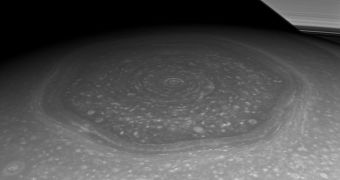Astronomers have known for a while that Saturn houses a very peculiar cloud pattern at its north pole, a hexagon. They don't know why and how it's formed, but it is one of the most striking features of the spectacular planet.
Cassini recently took a very clear and very beautiful photo of the polar hexagon, with Saturn's rings in the background.
"The image was taken with the Cassini spacecraft's wide-angle camera on Nov. 27, 2012 using a spectral filter sensitive to wavelengths of near-infrared light centered at 750 nanometers," NASA explained.
"The view was acquired at a distance of approximately 403,000 miles (649,000 kilometers) from Saturn and at a Sun-Saturn-spacecraft, or phase, angle of 21 degrees. Image scale is 22 miles (35 kilometers) per pixel," it added.
Each side of the hexagon is larger than the Earth's diameter, about 13,800 km, or 8,600 miles long. The hexagon rotates around its center every 10h 39m 24s. There's no hexagon at the south pole, but there are vortexes at both the south and the north pole.

 14 DAY TRIAL //
14 DAY TRIAL //